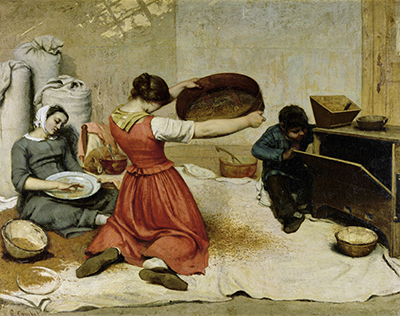The Wheat Sifters (Les Cribleuses de Blé) was completed by Gustave Courbet in 1854. It is typical of his work in that it depicts membres of the rural community going about their daily lives.
Artist Courbet saw this artwork as sharing part of a series alongside the likes of The Young Ladies of the Village. He desired to teach others of the ways of the rural communities that had for far too long been ignored within the French art world. The artist used his own sisters as models for both paintings, having the confidence that as fellow natives, they would easily be able to put across the local style that he so wished to deliver. It specifically outlining this, he described the finished paintings as "un tableau de moeurs de campagne". He was continually subjected to harsh criticism for depicting the 'ugly people' from the countryside, as some snobbish viewers commented.
The Wheat Sifters captures rural crafts at their best. Traditional methods were still very much a way of life during Courbet's period. In other paintings at around this time he would also draw attention to the different classes and how they might help each other from time to time. Several of his works feature peasants, servants plus also the middle classes. He was from an excellent background himself, but felt love for all of the members of his community.
The original artwork can be found at the Musée des Beaux-Arts de Nantes, France. Most of his paintings remain in his native country, though some have made their way to other parts of Europe or North America. This particular work was displayed at the Salon in Paris, a year after its completion. It was eventually sold to the Musée des Beaux-Arts de Nantes in 1861 and has remained in this institution ever since. Alongside this great work, you can also enjoy artwork by other famous names there such as Peter Paul Rubens, Tintoretto, Antoine Watteau, Edward Burne-Jones, Camille Corot, Jean Auguste Dominique Ingres and Wassily Kandinsky.




